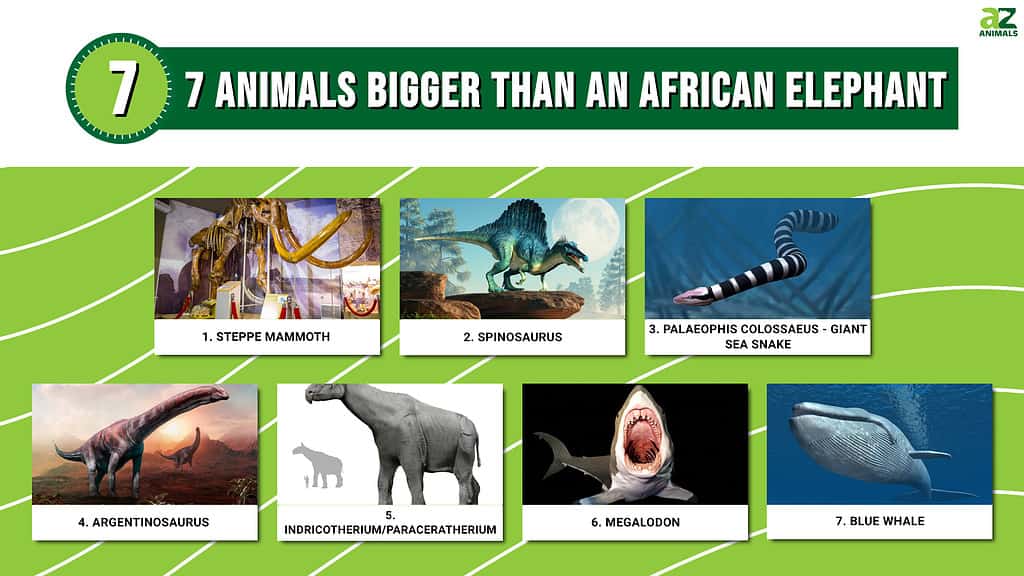
The African elephant is the biggest land animal on earth currently, and on average weighs between 4,000 to 14,000 lbs. The largest African elephant ever recorded weighed a whopping 24,000 lbs, showing how massive these animals are able to get.
In this article, you will discover 7 animals bigger than an African elephant, some of which are the largest animals to ever exist on Earth but are extinct.
African elephants vary in size like all species. Large animals are not uncommon on Earth, and going back millions of years you can find animals that grew to be incredibly large.
African elephants are one of the largest animals that currently exist, and there 7 animals that are able to get bigger than them.
Are There Any Mammals Bigger Than The African Elephant Alive Today?
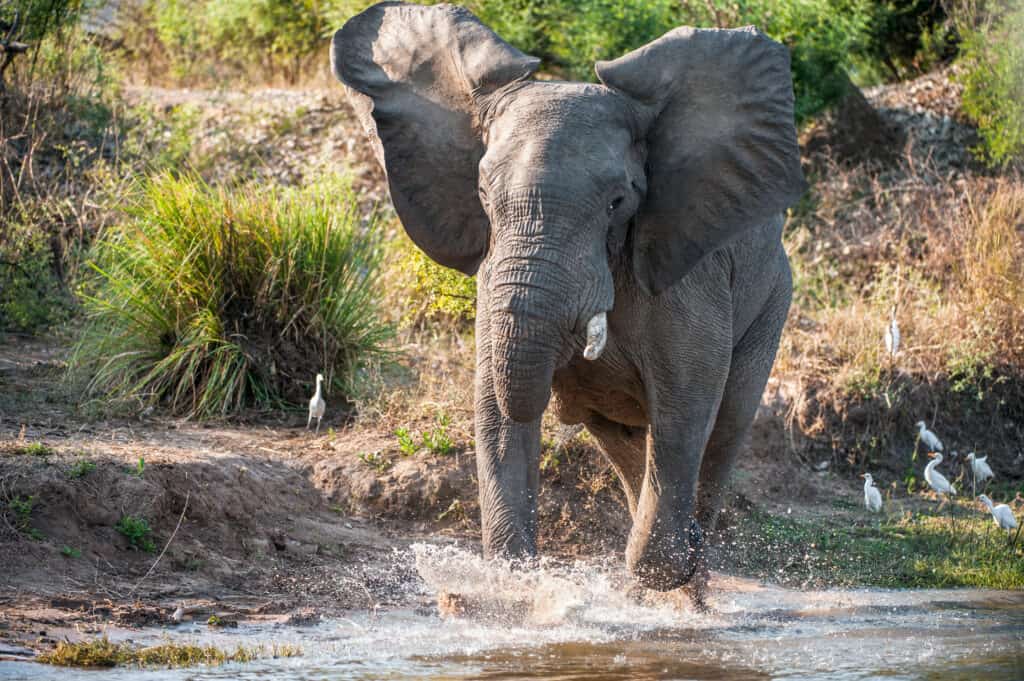
The African Elephant is the largest land animal in the world, with adult males weighing up to 14,000 pounds (6,350 kilograms) and standing over 10 feet (3 meters) tall.
©Sergey Uryadnikov/Shutterstock.com
The African Elephant is the largest land animal in the world, with adult males weighing up to 14,000 pounds (6,350 kilograms) and standing over 10 feet (3 meters) tall. However, some people may wonder if there are any mammals that are even larger than the African Elephant alive today. Here is what we know:
To date, there is no mammal that is larger than the African Elephant alive today. While there have been larger mammals in the past, such as the prehistoric Paraceratherium (also known as the Indricotherium) and Deinotherium, which lived millions of years ago, the African Elephant currently holds the title of the largest mammal on earth.
However, there are some species that come close to the size of the African Elephant. The Asian Elephant, for example, is a close relative of the African Elephant and is the second largest land animal in the world. Adult males can weigh up to 12,000 pounds (5,400 kilograms) and stand over 9 feet (2.7 meters) tall. While slightly smaller than their African cousins, Asian Elephants are still impressively large animals.
Another animal that is often compared to the African Elephant in terms of size is the Hippopotamus. While not as tall as elephants, hippos are incredibly large and heavy, with adult males weighing up to 4,000 pounds (1,800 kilograms). They are also known for their immense strength and are considered one of the most dangerous animals in Africa.
While the African Elephant is the largest land animal in the world, there are other species that come close to its size, such as the Asian Elephant and the Hippopotamus.
1. Steppe Mammoth

©VPales/Shutterstock.com
The steppe mammoth is the largest mammoth species to be discovered and is slightly bigger than an African elephant. This species lived around 1.8 to 200,000 million years ago and lived in the region of what is now northern Eurasia.
With a height of around 14.8 feet tall, the average steppe mammoth was estimated to weigh around 22,046 to 31,526 lbs.
The wooly mammoth is one of the most well-known mammoth species on the globe but is around the same size as the African Elephant. The change in plant life and temperature is one of the main reasons mammoths became extinct. Humans only lived alongside wooly mammoths for about 2,000 years and were not the cause of their extinction.
2. Spinosaurus
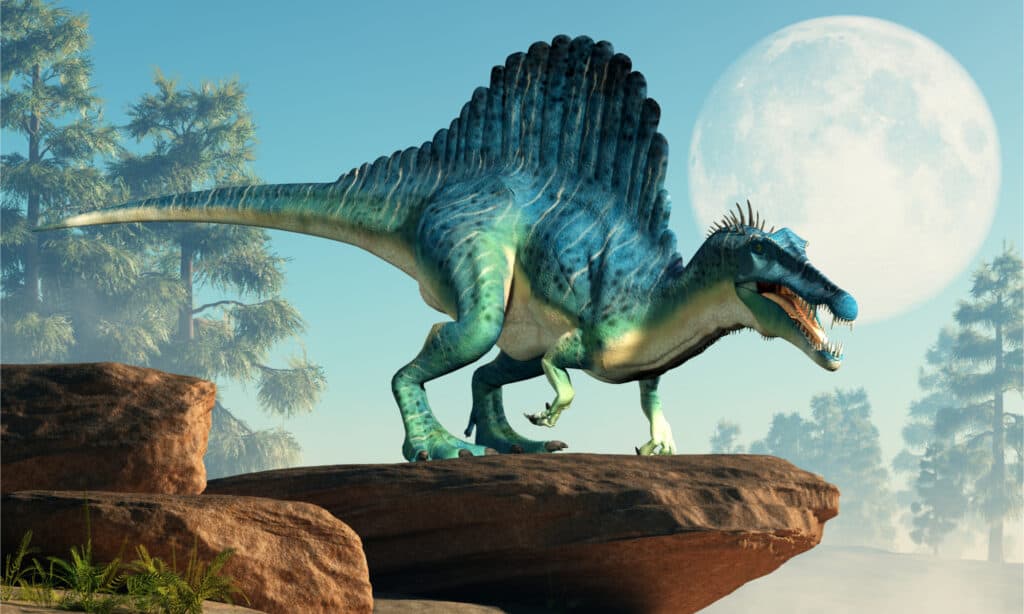
Spinosaurus is easily recognizable due to the spines on its back.
©Daniel Eskridge/Shutterstock.com
The spinosaurus was a large species that had a height of around 23 feet tall. This species lived in North Africa and inhabited the earth around 100 to 90 million years ago. Spinosaurus was also extremely heavy and weighed between 26,000 to 31,000 lbs.
Spinosaurus was the largest known carnivorous dinosaur to exist on Earth. It preyed on the smaller species of its time and was about 3 times bigger than an elephant.
3. Palaeophis colossaeus – Giant Sea Snake

The
largest sea snake
to have existed could eat whale calves.
©Nobu Tamura (http://spinops.blogspot.ca/) / Creative Commons – License
Palaeophis is a genus of ancient sea snakes that lived in the Eocene epoch around 56 to 33.9 million years ago. Around 3 species lived in this genus, and the largest of them all was Palaeophis colossaeus. This sea snake grew up to 40 feet long, and it is the biggest known snake. It is estimated based on their fossils that they weighed more than 17,000 lbs.
This snake was able to get so large because of the higher temperature of the sea at the time. Fossils of this genus have been discovered in places like England, Denmark, and Africa.
4. Argentinosaurus
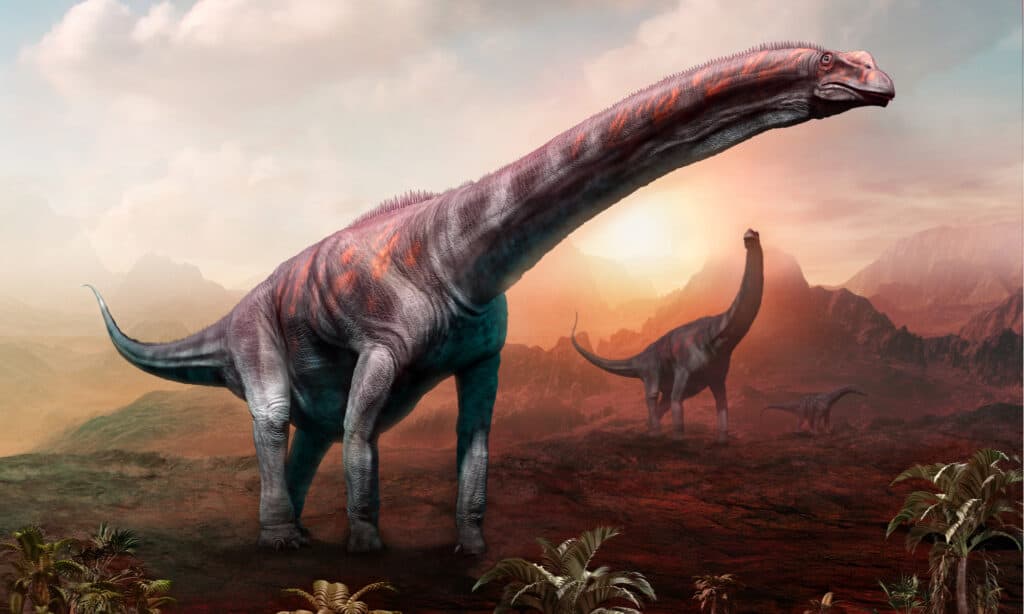
Argentinosaurus was the largest dinosaur to ever exist.
©Warpaint/Shutterstock.com
The Argentinosaurus is one of the largest dinosaurs ever to exist, and it is also one of the largest known animals to ever walk the Earth. Argentinosaurus grew to be 70 feet tall, which is roughly the size of a six-story building. In total, their body was around 98 to 115 feet long. Estimated to weigh around 110,000 to 220,000 lbs, they are also one of the heaviest land animals.
This large dinosaur was discovered in 1987, and its fossil remains were found on a ranch in Argentina. It was a member of the Sauropod clade, which also contains several large dinosaurs like the brachiosaurus. The largest sauropods were the titanosaurs.
5. Indricotherium/Paraceratherium
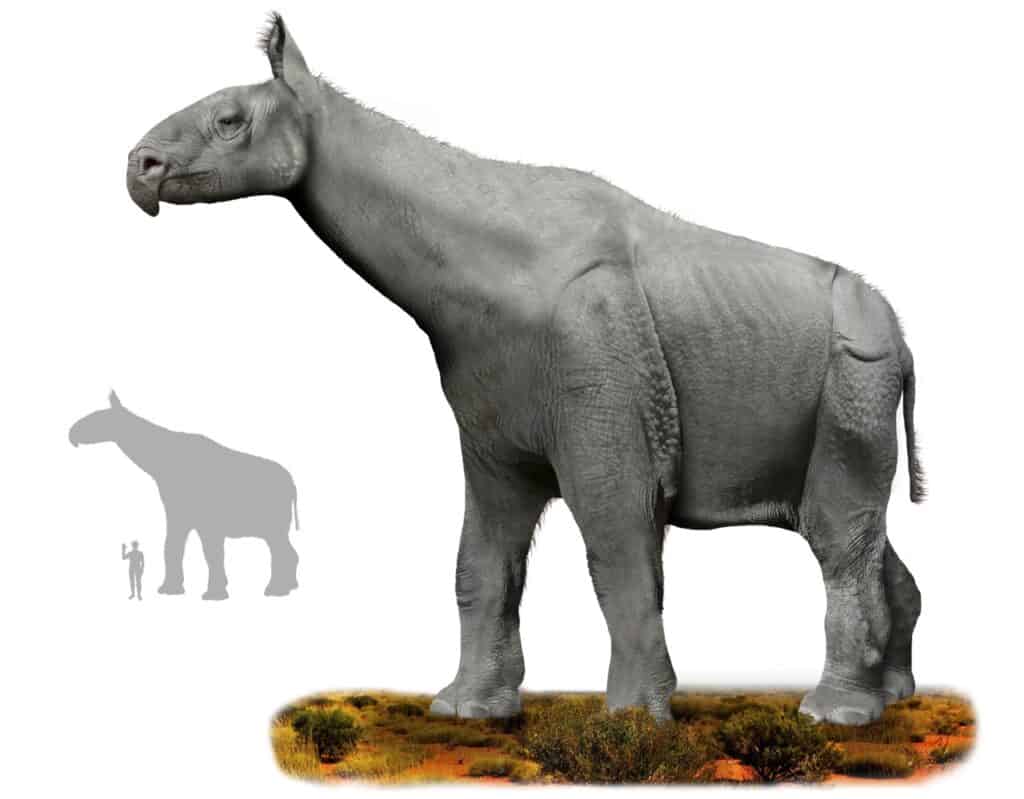
©Tim Bertelink / CC BY-SA 4.0 – License
A relative to the modern rhinoceros, the Indricotherium is a large species that lived between 34 to 23 million years ago. Indricotherium lived in central Asia and lived in forested habitats.
Standing at around 16 feet tall, the Indricotherium weighed a whopping 20 tons. Indricotherium, Paraceratherium, and Baluchitherium are the three names this species is referred to. When discovered, different names were used for this animal since it was thought to be different species.
As an herbivore, the Indricotherium would feed on leaves. They had long necks that were around 4.3 feet tall and used to reach leaves high in trees. Indricotherium is considered one of the largest and heaviest land mammals ever and is nearly 2 times bigger than an African elephant.
6. Megalodon

Megalodons weighed more than elephants.
©Gil Cohiba/Shutterstock.com
Among fish, the Megalodon was one of the largest to swim in the ocean, and they are also the largest shark ever. Megalodon existed around 20 million years ago, and they went extinct about 2.6 million years ago. Ocean temperatures cooling and the changing of climate are what caused megalodons to go extinct, but when alive they were one of the largest and fiercest predators.
Megalodons were estimated to grow between 49 to 60 feet long when fully mature and weighed around 110,200 lbs (50 tons). The largest megalodons had a jaw that opened up to 11 feet wide and was filled with over 250 teeth.
Like other similar sharks, megalodon teeth grew their entire life. A single tooth from this shark was around 7 inches long. Teeth fossils are quite common and have washed up on beaches around the globe.
7. Blue Whale
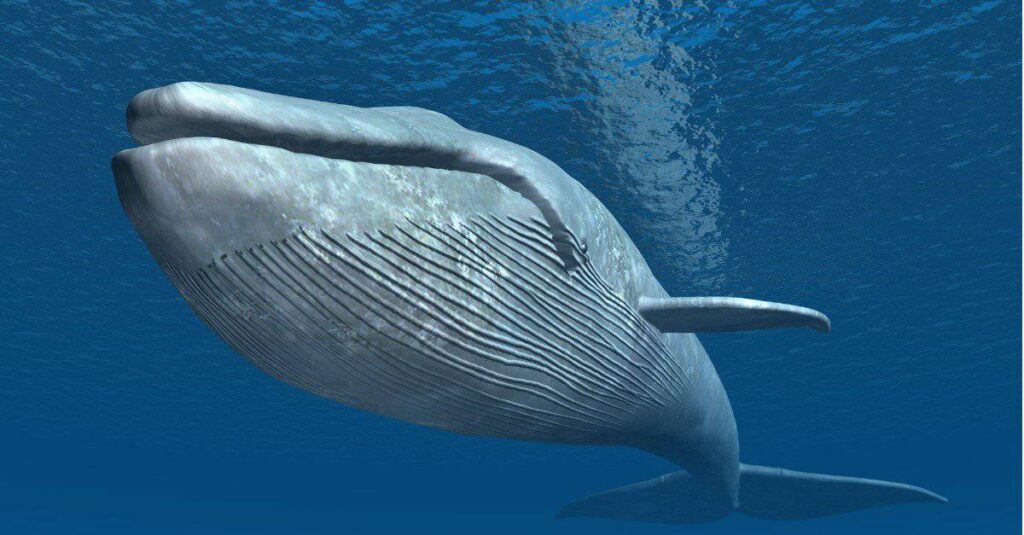
Blue weighs can be up to 100 feet long!
©iStock.com/MR1805
The blue whale is currently the largest animal on earth and is the heaviest of all the whale species currently. Blue whales grow between 75 to 100 feet large, and are extremely heavy, weighing between 220,000 to 352,000 lbs when fully mature. This species has blue/grayish coloring, and they inhabit all of the earth’s oceans except for the Arctic.
The large size of the blue whale is maintained by a diet of krill, and it is estimated they eat on average 16 tons of food a day. The blue whale is the largest known animal to ever exist and is comparable to the weight of 30 elephants.
While the blue whale is the largest, there are several other whale species that are able to grow much bigger than an African Elephant. The fin whale, sperm whale, and bowhead whale are just some examples of other large species, capable of weighing more than 100,000 lbs.
Honorable Mentions: Other Animals Larger Than an African Elephant

The Elasmotherium is a land mammal that would have outsized the African elephant hands down.
©Elenarts/Shutterstock.com
We took a close look at 7 animals that out-size the African Elephant, the largest land mammal in the world. There are even more animals larger than an elephant, and we wanted to make note of them.
- Titanboa The Titanoboa, a prehistoric snake whose fossils have been found in Colombia, South America, lived during the Paleocene epoch 60-58 million years ago. Its estimated size was 42 to 49 feet long with a weight of 1 to 2 tons.
- Sperm Whale Another sea mammal that outsizes the African elephant is the sperm whale, reaching lengths of 59 feet and weighing from 45 to 60 tons. They inhabit oceans worldwide.
- Dunkleosteus This animal was a prehistoric armored fish whose fossils have been uncovered in North America, Ohio in particular, as well as Morocco. Its estimated length was 33 feet, and it lived 358-382 million years ago during the late Devonian period.
- Elasmotherium A notable land mammal was a prehistoric rhino named Elasmotherium, which went extinct around 29,000 years ago during the Pleistocene epoch. Fossils of this massive creature, which stood 16 feet tall and weighed 3.6 to 4.5 tons, have been found in areas of Eurasia like Russia and Kazakhstan.
Summary Of The 7 Animals Bigger Than An African Elephant
| Rank | Animal | Size in Height & Weight |
|---|---|---|
| 1 | Steppe Mammoth | 14.8 feet tall, 22,046 to 31,526 lbs |
| 2 | Spinosaurus | 23 feet tall, 26,000 to 31,000 lbs |
| 3 | Palaeophis colossaeus- Giant Sea Snake | 40 feet long, 17,000 lbs |
| 4 | Argentinosaurus | 70 feet tall, 110,000 to 220,000 lbs |
| 5 | Indricotherium/Paraceratherium | 16 feet tall, 20 tons |
| 6 | Megalodon | 49 to 60 feet long, 110,200 lbs (50 tons) |
| 7 | Blue Whale | 75 to 100 feet, 220,000 to 352,000 lbs |
The photo featured at the top of this post is © AndyElliott/Shutterstock.com
Sources
- Dallas Mineral Collecting Symposium, Available here: https://www.mindat.org/taxon-4968172.html
- World Wildlife, Available here: https://www.worldwildlife.org/species/blue-whale
- Natural History Museum, Available here: https://www.nhm.ac.uk/discover/dino-directory/argentinosaurus.html
Thank you for reading! Have some feedback for us? Contact the AZ Animals editorial team.






